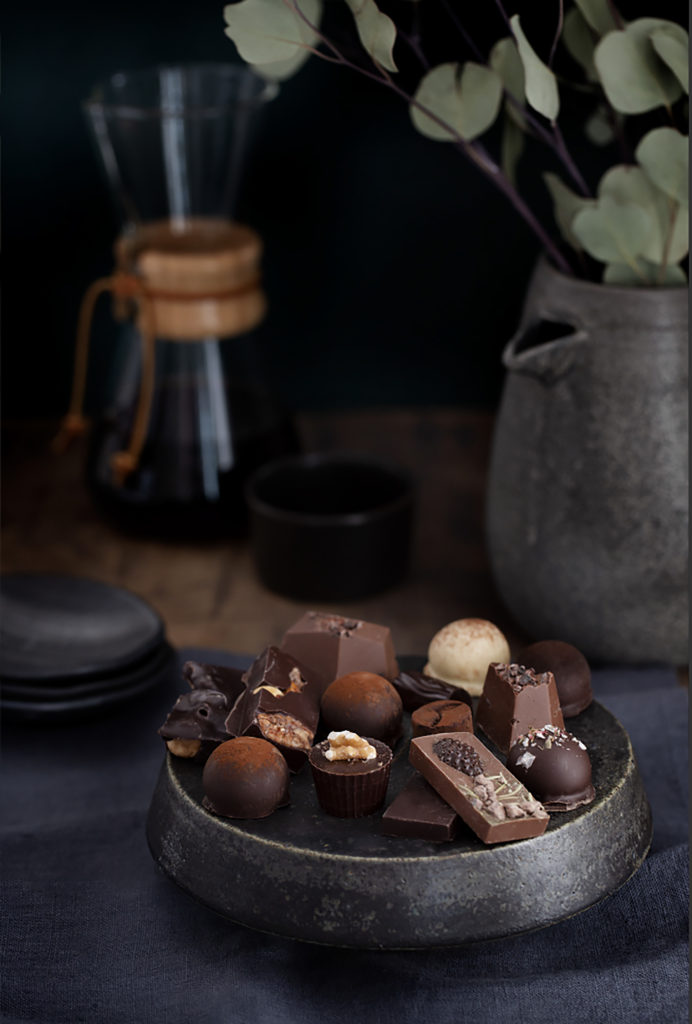Chocolate Guide

We design our chocolates to create all-sensory experiences, so they are beautiful to behold and to savor, to eat slowly and luxuriate in the different flavor notes of the chocolate itself and the premium flavorful ingredients we use in our recipes.
Below are some simple chocolate tips to help you get the most out of your chocolate tasting experience.
Check out our FAQ page for more information about chocolate sourcing, terminology, storage, tempering and more, and our Bonbon Flavors page for photos and descriptions.
Explore our chocolate pairing suggestions for harmonious chocolate and wine, craft beer, artisan cheese, fruit and nut combinations, and to create the ultimate cheese and chocolate board.
Bon appétit!
Chocolate Tasting Guide
Start with a clean palate (eat a small piece of plain bread or cracker and take a sip of water).
Look
A well-tempered solid chocolate or chocolate shell typically looks shiny, with the exception of inclusions on top (cocoa powder nuts, etc.), or the artistic approach of the chocolatier.
Does the chocolate look shiny, matte, textured, blotchy, grainy? What inclusions can you see, if any (salts, nuts, flowers, etc.)?
Listen
Well-tempered solid chocolate, be it a bar or bonbon shell, is crisp and makes a bright snapping sound when you break off a piece or bite into it. A soft truffle or nut cluster will make no sound, or a soft crunch.
When you break a piece off a bar or bite into a filled chocolate, an uncoated truffle or a cluster, what sound does it make?
Feel
A chocolate ganache (the center of a chocolate truffle or filled chocolate, made of pure chocolate gently melted with cream and/or butter and possibly flavorful ingredients) should be smooth, unctuous and creamy, or it can be chewy or crunchy depending on other ingredients like caramel, nuts, fruits, etc. A tempered chocolate bar should melt slowly and evenly on the tongue, turning velvety and releasing the inclusions (added ingredients for flavor and texture, like nuts, salts, etc).
When you slice into Chocolate Charcuterie or bite into a truffle or bar is it smooth and silky? Studded with nuts and other textures?
Touch
Solid chocolate should feel firm and start to just slightly melt in between your fingers, since its melting point is right around human body temperature. It shouldn’t feel soft, oily/waxy (a sign of added vegetable oils, something we never use, instead of pure cocoa butter), gritty or crumbly.
Smell
Cup your hands around the chocolate and smell: breathe in deeply with your eyes closed.
What aromas do you notice?
Floral, nuts, caramel, earthy, tobacco, fruits? How do the aromas travel and appear?
Do you notice the chocolate aromas first, or the aromas of some of the inclusions, or a combination of both at once?
How are they layered?
Taste
The most important part! Take a bite of solid chocolate or bite into a filled chocolate, truffle or a piece of charcuterie, moving the chocolate around to different parts of your tongue, letting it melt slowly.
What flavor notes do you notice first? Second, and so on?
How do the flavors travel across your palate, and with time?
After the chocolate has fully melted, which flavors linger or show up as after tastes?
For more chocolate information including its history and how chocolate is grown and made, explore these resources:
- Bittersweet Notes, Fine Cacao & Chocolate Institute Dr. Carla D. Martin
- Chocolate Alchemy John Nanci
- Chocolate Noise Megan Giller
- Bread, Wine, Chocolate: The Slow Loss of Foods We Love Simran Sethi
- The New Taste of Chocolate: A Cultural & Natural History of Cacao with Recipes Maricel E. Presilla
